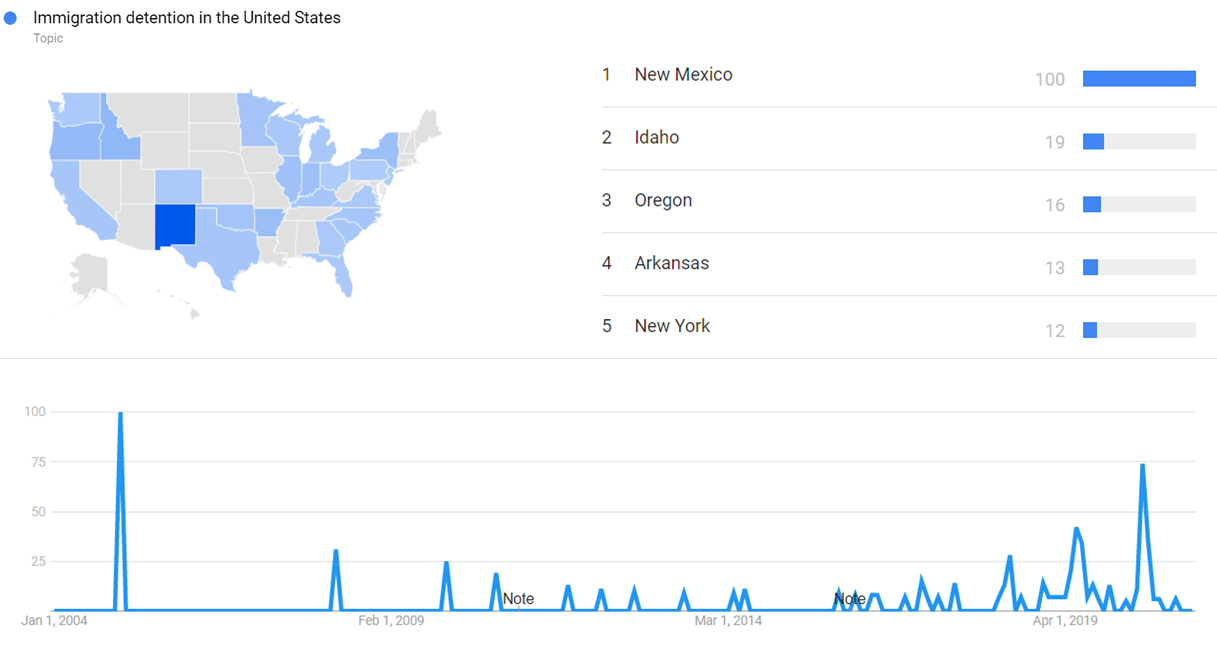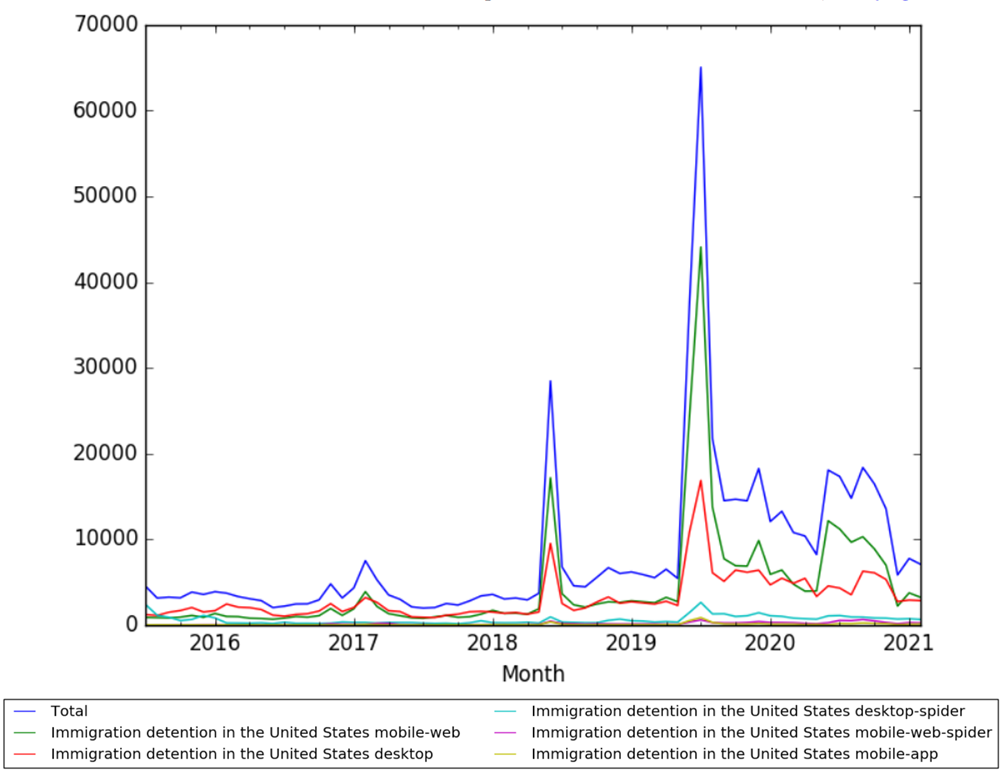Difference between revisions of "Timeline of immigration detention in the United States"
(→Visual data) |
|||
| Line 12: | Line 12: | ||
[[File:Immigration detention in the United States gt.png|thumb|center|800px]] | [[File:Immigration detention in the United States gt.png|thumb|center|800px]] | ||
| + | |||
| + | === Wikipedia Views === | ||
| + | |||
| + | The chart below shows pageviews of the English Wikipedia article {{w|Immigration detention in the United States}}, on desktop, mobile-web, desktop-spider, mobile-web-spider and mobile app from July 2015; to February 2021.<ref>{{cite web |title=Immigration detention in the United States |url=https://wikipediaviews.org/displayviewsformultiplemonths.php?page=Immigration+detention+in+the+United+States&allmonths=allmonths-api&language=en&drilldown=all |website=wikipediaviews.org |access-date=14 March 2021}}</ref> | ||
| + | |||
| + | [[File:Immigration detention in the United States wv.png|thumb|center|800px]] | ||
== Full timeline == | == Full timeline == | ||
Revision as of 13:17, 14 March 2021
This timeline covers immigration detention in the United States.
It is a complement to the timeline of immigration enforcement in the United States and timeline of immigrant processing and visa policy in the United States.
See also List of detention sites in the United States fr a list of detention centers.
Visual data
Google Trends
The image below shows Google Trends data in United States for Immigration detention in the United States (Topic) from January 2004 to March 2021, when the screenshot was taken. Interest is also ranked by state and displayed on map.[1]
Wikipedia Views
The chart below shows pageviews of the English Wikipedia article Immigration detention in the United States, on desktop, mobile-web, desktop-spider, mobile-web-spider and mobile app from July 2015; to February 2021.[2]
Full timeline
| Year | Month and date (if available) | Event type | Affected agencies (past, and present equivalents) | Details |
|---|---|---|---|---|
| 1892 | Immigration inspection station | Ellis Island becomes an immigration inspection station, handling immigrants arriving via the Atlantic. Immigrants could be temporarily detained upon arrival for closer examination, or to hold till they are deported. | ||
| 1902 | Immigration inspection station | The Ellis Island Immigrant Hospital is opened. It is both a general hospital and a contagious disease hospital. It also serves as a detention facility for new immigrants deemed unfit to enter the United States or held back for further examination. | ||
| 1910 | Immigration inspection station | Angel Island Immigration Station, an immigrant inspection facility with a detention center, opens for operations. It handles immigrants arriving via the Pacific. | ||
| 1997 | January 28 | Agreement | Executive branch | During the presidency of Bill Clinton, an agreement is reached regarding the permissible conditions for detaining child migrants, commonly called the Flores Agreement or Flores Settlement. This is a follow-up to the Supreme Court case Reno v. Flores. The three obligations identified for the government are: (1) The government is required to release children from immigration detention without unnecessary delay to, in order of preference, parents, other adult relatives, or licensed programs willing to accept custody. (2)If a suitable placement is not immediately available, the government is obligated to place children in the "least restrictive" setting appropriate to their age and any special needs. (3) The government must implement standards relating to the care and treatment of children in immigration detention.[3] |
| 2001 | June 28 | Court ruling | Zadvydas v. Davis is decided. The court rules that the plenary power doctrine does not authorize the indefinite detention of immigrants under order of deportation whom no other country will accept. To justify detention of immigrants for a period longer than six months, the government was required to show removal in the foreseeable future or special circumstances. | |
| 2003 | March 1 | Organizational restructuring | Immigration and Naturalization Services and U.S. Department of Homeland Security | The Immigration and Naturalization Services (INS) (that was under the Department of Justice) is disbanded. Its functions are divided into three sub-agencies of the U.S. Department of Homeland Security: United States Citizenship and Immigration Services (USCIS), Immigration and Customs Enforcement (ICE), and Customs and Border Protection (CBP). |
| 2003 | Detention center | The Willacy County Regional Detention Center opens for operations in Raymondville, Texas, operated by Management and Training Corporation under contract with the United States Marshal Service. | ||
| 2004 | Detention center | The Stewart Detention Center opens for operations in Lumpkin, Georgia. | ||
| 2004 | Detention center | The Northwest Detention Center opens for operations in Tacoma, Washington, operated by Correctional Services Corporation on contract with the U.S. Department of Homeland Security. | ||
| 2005 | May | Detention center | The South Texas Detention Facility, a privately operated prison, opens for operation in Pearsall, Texas as the Pearsall Immigration Detention Center. The prison houses people for the U.S. Immigration and Customs Enforcement as well as United States Marshal Service. | |
| 2005 | October | Detention center expansion plan | Michael Chertoff, then Secretary of Homeland Security, calls for an increase in detention center capacity so that the United States immigration enforcement can hold people in detention between the time of catching them and the time of their immigration hearings, and does not need to resort to catch and release.[4] | |
| 2006 | July | Chertoff indicates in House committee testimony that an infusion of funding for more immigration detention has allowed DHS to detain almost all non-Mexican illegal immigrants.[5] | ||
| 2011 | August | Detention center | ICE | The East Wing of the Adelanto Detention Center, a detention facility managed by GEO Group for ICE, opens for operation. The facility had previously been a state prison for adult male inmates before the GEO Group purchased it in 2010 and contracted with ICE in May 2011 to use it for immigration detention. The West Wing would open in July 2012. |
| 2014 | Detention center | CBP | The Ursula detention center, the largest detention center operated by Customs and Border Protection, opens for operation in McAllen, Texas. In June 2018, it gained notoriety for the practice of keeping children in large cages made of chain-link fencing.[6] | |
| 2014 | December | Detention center (family detention) | The South Texas Family Residential Center opens in Dilley, South Texas. It has a capacity of 2,400 and is intended to detain mainly women and children from Central America. It is managed by the Corrections Corporation of America.[7] | |
| 2018 | June 14 | Detention center (temporary shelter) | DHS/ICE | The Tornillo tent city appears to have started operation around this time, as a temporary shelter to detain migrants. It would be shut down in January 2019. |
References
- ↑ "Immigration detention in the United States". Google Trends. Retrieved 14 March 2021.
- ↑ "Immigration detention in the United States". wikipediaviews.org. Retrieved 14 March 2021.
- ↑ "The Flores Settlement: A Brief History and Next Steps". Human Rights First. February 19, 2016. Retrieved June 19, 2018.
- ↑ "Chertoff: End 'Catch and Release' at Borders". Associated Press via Fox News. October 18, 2005. Retrieved July 18, 2015.
- ↑ "Chertoff hails end of let-go policy". Washington Times. July 28, 2006. Retrieved July 18, 2015.
- ↑ Frej, Willa (2018-06-18). "These Are The Texas Immigration Center Photos Stirring Anti-Trump Outrage". Huffington Post. Archived from the original on 18 June 2018. Retrieved 2018-06-18.
- ↑ "South Texas immigration detention center set to open". 15 December 2014. Retrieved 19 December 2014.

